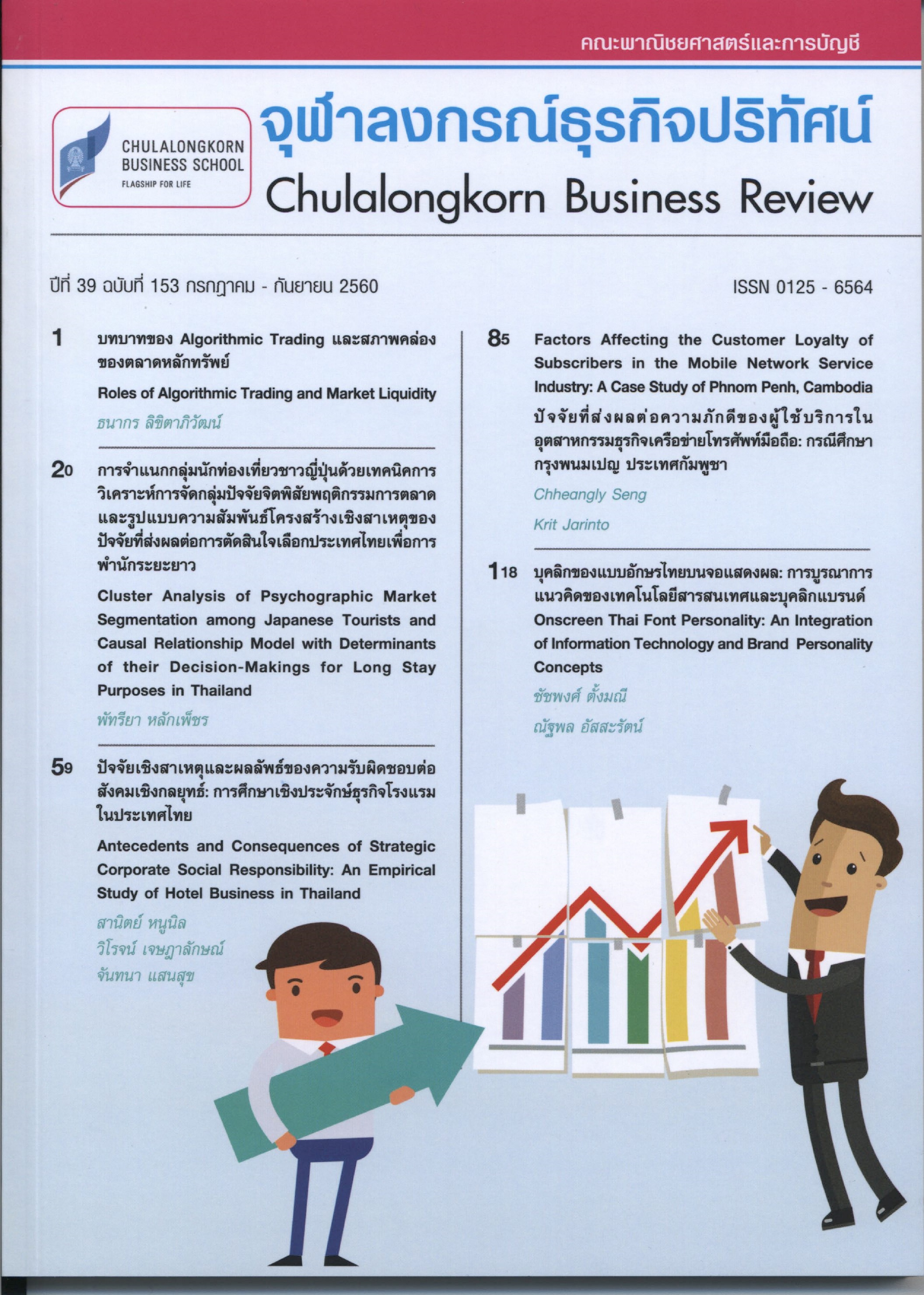บทบาทของ Algorithmic Trading และสภาพคล่องของตลาดหลักทรัพย์
Main Article Content
Abstract
บทคัดย่อ
กลไกการซื้อขายของตลาดหลักทรัพย์ทั่วโลกมีการเปลี่ยนแปลงไปอย่างมากจากการเข้ามาของเทคโนโลยีคอมพิวเตอร์ อัลกอริทึ่มเทรดดิ้ง (Algorithmic Trading - AT) เป็นเครื่องมือชนิดใหม่ที่ช่วยในการอำนวยความสะดวกในการซื้อขายหลักทรัพย์ให้แก่ผู้เล่นในตลาด การศึกษาในต่างประเทศพบว่า AT เป็นประโยชน์แก่ตลาดในหลายด้าน เช่น เพิ่มสภาพคล่องให้แก่ตลาด เพิ่มประสิทธิภาพของราคาหลักทรัพย์ ทำให้โอกาสในการทำกำไรโดยปราศจาความเสี่ยงลดลง และต้นทุนการซื้อขายต่ำลง แต่บางการศึกษาก็พบหลักฐานที่ขัดแย้งว่า AT ไม่ก่อให้เกิดประโยชน์แต่อย่างใด สภาพคล่องไม่ได้เพิ่มขึ้นแต่กลับทำให้มีความผันผวนมากขึ้น สำหรับตลาดหลักทรัพย์แห่งประเทศไทยอนุญาตให้นักลงทุนใช้ AT ส่งคำสั่งซื้อขายได้ตั้งแต่ปี 2549 จากการศึกษาโดยหลักฐานเชิงประจักษ์พบว่านักลงทุนที่ใช้ AT ในไทยมีพฤติกรรมทั้งในด้านที่ช่วยสร้างสภาพคล่อง (ใช้ Limit Order) และดูดสภาพคล่อง (ใช้ Market Order) โดยขึ้นกับสภาวะตลาดที่แตกต่างกัน โดยภาพรวม AT มีพฤติกรรมในการเฝ้าติดตามสภาวะตลาดมากกว่านักลงทุนทั่วไป แต่การใช้ AT ของไทยยังไม่อยู่ในระดับที่ใช้ความเร็วและความถี่สูงมากเมื่อเทียบกับในตลาดหลักทรัพย์ของประเทศที่พัฒนาแล้ว
Abstract
An advent of computer technology cause dramatic change in securities exchange mechanism worldwide. Algorithmic trading (AT) is a rising tool that enables securities trading of market participants, mostly institutional traders, to be more convenient. Studies on AT in several markets show that it benefits in many ways such as adding liquidity to the markets, improve price efficiency, reduce arbitrage opportunity and reduce trading costs. However, some studies find the opposite. AT does not improve liquidity but instead increase volatility. Stock Exchange of Thailand (SET) has allowed the algorithmic trading since 2006. According to empirical study of AT in the SET, ATs both adding liquidity by using limit orders and consuming liquidity by using market orders depending on different market conditions. In general, AT shows greater degree of market monitoring behaviors than others. However, AT in the SET does not exhibit high level of speed and frequency relative to that of developed exchanges
Article Details
Opinions and discussions in papers published by the Creative Business and Sustainability Journal (CBSJ) are deemed as personal opinions and the responsibility of the writers. They are not the opinions or responsibility of the Chulalongkorn Business School of Chulalongkorn University.
Papers, content, information etc. appearing in the Journal are deemed to be the copyright property of the Chulalongkorn Business School of Chulalongkorn University. Anybody or any organization that wishes to publish any part of them or use them in any way must obtain written permission from the Chulalongkorn Business School, Chulalongkorn University.
References
Biais, B., Hillion, P., and Spatt, C. (1995). An Empirical Analysis of the Limit Order Book and the Order Flow in the Paris Bourse. Journal of Finance, Vol 50, pp. 1655 – 1689.
Bunnag, A. V. (2011). A Closer Look at High Frequency Trading: New Direction of Asian Capital Markets. Research Note. Stock Exchange of Thailand. Vol 4. (In Thai)
Brogaard, J., Hendershott, T., and Riordan R. (2014). High-Frequency Trading and Price Discovery. Review of Financial Studies, Vol 27, pp. 2267 – 2306.
Budish, E., Cramton, P., and Shim, J. (2015). The High-Frequency Trading Arms Race: Frequent Batch Auctions as a Market Design Response. Quarterly Journal of Economics, Vol. 130, pp. 1547 – 1621.
Chaboud, A. P., Chiquoine, B., Hjalmarsson, E., and Vega, Clara. (2014). Rise of the Machines: Algorithmic Trading in the Foreign Exchange Market. Journal of Finance, Vol 69, pp. 2045 – 2084.
Chlistalla, M. (2011). High-Frequency Trading: Better than its Reputation? Deutsche Bank Research.
Conrad, J., Wahal, S., and Xiang, J. (2015). High Frequency Quoting, Trading and the Efficiency of Prices. Journal of Financial Economics, Vol 116, pp. 271 – 291.
Copeland., T. E., and Galai, D. (1983). Information Effects on the Bid-Ask Spread. Journal of Finance, Vol 38, pp. 1457 – 1469.
Egginton, J. F., Van Ness, B., and Van Ness, R. (2016). Quote Stuffing. Financial Management, Vol 45, pp. 583 – 608.
Foresight, (2012). Foresight: The Future of Computer Trading in Financial Markets. Final Project Report. The Government Office for Science, London.
Frino, A., Prodromou, T., Wang, G., Westerholm, P. J., and Zheng, H. (2016). An Empirical Analysis of Algorithmic Trading around Earnings Announcements. Pacific-Basin Finance Journal, Available Online 25 May 2016.
Garman, M. B. (1976). Market Microstructure. Journal of Financial Economics, Vol 3, pp. 257 – 275.
Garvey, R., and Wu, F. (2010). Speed, Distance, and Electronic Trading: New Evidence on Why Location Matter. Journal of Financial Markets, Vol. 13, pp. 367 – 396.
Glosten, L. R. and Milgrom, P. R. (1985). Bid, Ask and Transaction Prices in a Specialist Market with Heterogeneously Informed Traders. Journal of Financial Economics, Vol 14, pp. 71 – 100.
Hagströmer, B., and Nordén, L. (2013). The Diversity of High-Frequency Traders. Journal of Financial Markets, Vol 16, pp. 741 – 770.
Hasbrouck, J., and Saar, G. (2013). Low-latency trading. Journal of Financial Markets, Vol 16, pp. 646 – 679.
Hendershott, T. and Jones, C. M., Menkveld, A. J. (2011). Does Algorithmic Trading Improve Liquidity? Journal of Finance, Vol 66, 1 – 33.
Hendershott, T., and Riordan R. (2013). Algorithmic Trading and the Market for Liquidity. Journal of Financial and Quantitative Analysis, Vol 48, pp. 1001 – 1024.
Hu, G.X., Pan, J., and Wang, J. (2016). Early Peek Advantage? Working Paper. University of Hong Kong.
Johnson, B. (2010). Algorithmic Trading & DMA: An Introduction to Direct Access Trading Strategies. 4Myeloma Press. London.
Jovanovic, B., and Menkveld, A. J. (2011). Middlemen in Limit-Order Markets. Working Paper. New York University.
Lewis, M. (2014). Flash Boys: A Wall Street Revolt, W. W. Norton & Company.
Likitapiwat, T. (2016). Algorithmic Trading in an Emerging Market: Empirical Study on the Stock Exchange of Thailand. CMRI Working Paper 1/2016. Stock Exchange of Thailand.
Menkveld, A. J. (2013). High Frequency Trading and the New Market Makers. Journal of Financial Markets, Vol 16, pp. 712 – 740.
Parlour, C. A. (1998). Price Dynamics in Limit Order Market. Review of Financial Studies, Vol 11, pp. 789 – 816.
Scholtus, M., Dijk, D. V., and Frijns, B. (2014). Speed, Algorithmic Trading, and Market Quality around Macroeconomic News Announcements. Journal of Banking and Finance, Vol 38, pp. 89 – 105.


